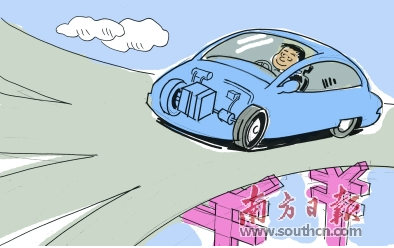Although hydrogen fuel cell vehicles are developing rapidly, there are still technical bottlenecks
As one of the main technological paths of new energy vehicles, hydrogen fuel cell vehicles have been confirmed to be vigorously developed in important strategic outlines such as "National Innovation-Driven Development Strategy Outline", "Made in China 2025", and "Mid and Long-term Development Plan for the Automobile Industry". According to relevant plans, my country will have 2 million hydrogen fuel cell vehicles by 2030.
So, does this mean that hydrogen fuel cell vehicles have ushered in the wind? Analysts pointed out that there have been substantial breakthroughs in current hydrogen fuel cell vehicle-related technologies, and policies are continuously increasing guidance. However, for large-scale development in the future, in addition to the core technology of hydrogen fuel cell vehicles, the key lies in accelerating the improvement of infrastructure, continuously strengthening demonstration operations, and exploring new business operation models.

Compared with electric vehicle battery energy storage, which has the defect of low energy density, the characteristics of zero emission and zero pollution of hydrogen fuel cell vehicles are considered by the industry as an ideal technology for clean and environmental protection in the future.
In terms of hydrogen fuel cell vehicle technology, Japan, South Korea and other countries are at the forefront. According to public information, Toyota Motor began to develop hydrogen fuel cell vehicles in 1992. In 2014, its first mass-produced hydrogen fuel cell vehicle, Mirai, was launched and marketed. Sales. Honda Motor also launched its own hydrogen fuel cell car Clarity. Hyundai of South Korea strongly advocates hydrogen fuel cells, and recently released the first hydrogen fuel cell vehicle NEXO at the Beijing Auto Show.
In fact, hydrogen fuel cell vehicles, as one of the main technical routes of new energy vehicles, have clearly stated that they must be vigorously promoted in the "National Innovation-Driven Development Strategy Outline", "Made in China 2025", and "Mid and Long-term Development Plan for the Automobile Industry" development of.
According to the plan of "China's Hydrogen Energy Industry Infrastructure Development Blue Book (2016)", my country will take the lead in realizing the large-scale promotion and application of hydrogen vehicles and hydrogen refueling stations by 2020, reaching 10,000 fuel cell transportation vehicles; by 2030, The number of fuel cell vehicles has reached 2 million. This means that by then, the output value of my country's hydrogen car industry is expected to exceed the trillion yuan mark.
It is precisely the broad development space. At present, in addition to Foshan and Yunfu in Guangdong, Shanghai, Rugao in Jiangsu, Taizhou in Zhejiang, and Wuhan in Hubei have all introduced policies to support the development of hydrogen fuel cell vehicles.
In the first quarter of this year, dozens of hydrogen fuel cell buses have been delivered in the Beijing-Tianjin-Hebei region, and 74 are expected to be delivered in the second quarter; 28 hydrogen fuel cell buses in Foshan are in trial operation, and 300 vehicles will continue to be put into use this year; 500 hydrogen Fuel cell logistics vehicles were launched in Shanghai for demonstration and promotion operations.
Bottleneck: insufficient basic supporting facilities restrict scale promotionAlthough the prospects are relatively optimistic, the promotion of hydrogen fuel cell vehicles globally is still relatively weak. According to a survey conducted by the international consulting agency E4tech, as of November 2017, the cumulative global sales of fuel cell passenger vehicles was about 6,000, which is less than one-tenth of China’s 2017 sales of 468,000 pure electric passenger vehicles. .
At present, hydrogen fuel cell vehicles are mainly facing technical bottlenecks in core components, especially the life of the stack. Zhao Jishi, a distinguished young researcher of Foshan University of Science and Technology and the Yunfu (Foshan) Hydrogen Energy Standardization Innovation R&D Center, said that although the life of my country’s current stack has exceeded 5,000 hours, because the vehicle stack is a system, it also includes humidifiers, air The compatibility of necessary core components such as compressors and hydrogen circulation pumps is an important factor that determines the overall performance of the stack system, and the localization rate of these components is still low.
Fast Lithium Battery Charger,Scooter Li-Ion Battery Charger,36V 7A Lithium Battery Charger,Smart Li-Ion Battery Charger
HuiZhou Superpower Technology Co.,Ltd. , https://www.spchargers.com